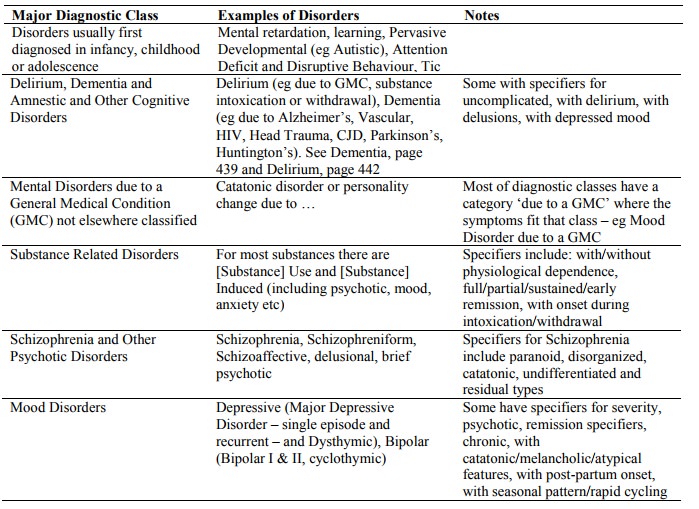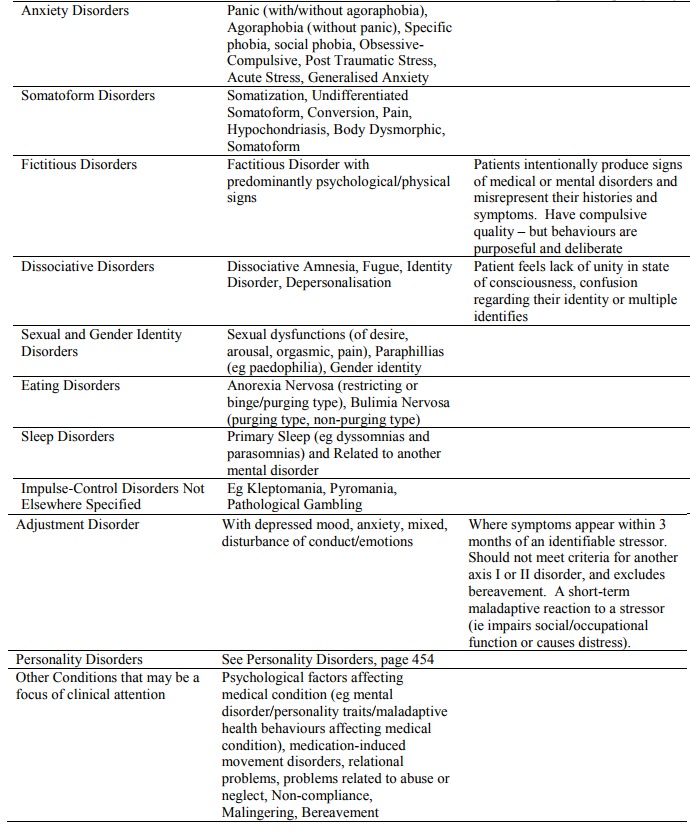Chapter: Medicine Study Notes : Psychological Medicine
DSM IV Classification
DSM IV Classification
·
Published 1994, replaces
Diagnostic and Statistical Manual of Mental Disorders III and III-R
Diagnostic Axises
·
Axis 1: Clinical Disorders eg
major depression, adjustment disorder, schizophrenic disorder. Basis in medical
model
·
Axis 2: personality disorder or
traits and mental retardation. More blurred distinction between person and
pathology
·
Axis 3: General Medical
Conditions (physical disorders and conditions)
·
Axis 4: Psychosocial and
Environmental Problems (eg severity of psychosocial stressors, problems with
primary support group, social environment, educational, occupational, housing,
economic, access to health care system)
·
Axis 5: global assessment of
functioning (eg in the previous year)
Diagnostic Classes


Using DSM Diagnoses*
·
In DSM IIIR, “Delirium, Dementia
and Amnestic and Other Cognitive Disorders”, “Mental Disorders Due to a General
Medical Condition” and “Substance-Related Disorders” were grouped under the
single heading “Organic Mental Syndromes and Disorders”. “Organic mental
disorder” is no longer used as it implies other disorders don‟t have a biological
basis
·
Qualifiers on Diagnostic codes:
o Severity and course specifiers: mild, moderate, severe, in partial
remission, in full remission, prior history of (ie have had full recovery)
o Principal diagnosis/Reason for visit: if more than one diagnosis, which
one was the principle one leading to admission/contact. Difficult to determine
in dual diagnosis (substance related + non-substance related). Multiple
diagnoses can re reported in multiaxial fashion
o Provisional: when strong assumption that criteria will be meet, but
insufficient evidence currently available
·
Not-otherwise specified used
when:
o Symptoms below clinical threshold or there is an atypical or mixed
presentation
o Symptom pattern is not included in DSM IV
o When there is uncertainty about aetiology: eg whether it is due to a
general medical condition, is substance induced or is primary
o There is incomplete or inconsistent information
·
Frequently used criteria – to
exclude or suggest differential diagnoses:
o Criteria have never been/are not meet for…
o Does not occur exclusively during the course of…
o Not due to the direct physiological effects or a substance of a general
medical condition – ie these have had to have been considered and ruled out
o Not better accounted for by…
·
These criteria establish a hierarchy:
o Disorders due to a general medical condition or substance-induced
disorder pre-empts diagnoses of primary disorder with the same symptoms (eg
Cocaine-induced mood disorder pre-empts Major Depressive Disorder)
o A more pervasive disorder pre-empts diagnosis of a less pervasive
disorder with a subset of the symptoms of the more pervasive disorder (eg Less
pervasive disorder will have „Criteria have not been meet for [the more
pervasive disorder])
o When there are very difficult diagnostic boundaries, use „not better
accounted for‟ to permit use of clinical judgement
Related Topics